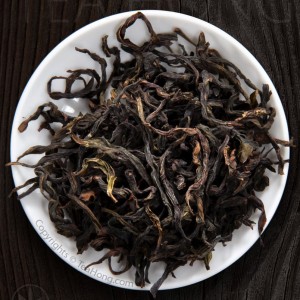Rougui, the Wuyi oolong before Shuixian

From a batch of fine Rougui matured for 3 years. Notice the much smaller leaf size compared to various Wuyi Shuixians. The matte surface is not an indication of maturity— the fresh tea is like that too, it is rather an indication of better processing.
Rougui ( ròu•guì 肉桂, i.e. Chinese cinnamon, aka Yugui, Cassia) is both the name of a popular cultivar in the area as well as the tea that is produced from that cultivar. The tea is not related to the tree of the same name which bark is used as a spice. There is no other relationship than the name between the tea and the spice.
Rougui stands out from other Wuyi oolongs not because of its difference as a cultivar, but rather a distinctive gastronomic character. Quality ranges hugely and finer ones taste sharp, bright and pleasingly bitter with a distinctive cinnamon accent in the aroma and a sweet, milk-like undertone. Finer ones are floral, smooth and full-bodied.
Traditional ones are typically more fermented than present day Wuyi Shuixians and yet more mildly fired. As a result, they can be consumed fresh off as well as matured, as different from the often over-fired Wuyi Shuixians.
origin
Before Wuyi Shuixian and their famous cultivars were honoured, Rougui had been praised by scholars in the early 1700’s, mentioning especially its seductive bitterness and cinnamon accent. (note)
Since the 1980’s the cultivar has spread widely to all areas in Wuyi and beyond, making it one of the most employed ones after Shuixian and Meijian in the region. Because of its distinctive taste and relative lesser fame than the other names, it is often used either as blend, or straight, to disguise as the tea from famous Shuixian cultivars, such as Da Hongpao, Tie’lohan etc. Since even fewer people really know what a tea from these latter cultivars should taste like. The same fate happens in a broader scale to the lower price, not as fine-tasting Meijian.

Spring flush ( ie first flush ) young leaves of Wuyi Rougui. Unlike that for other tea categories, plucking of leaves for oolongs takes place when the leaves are much more open and grown. It would be about 1 weeks before these leaves could be plucked, although the leaves for rougui are already amongst the youngest to be plucked in all Wuyi oolongs.
Luckily, as more farmers and producers set up their direct sales channels rather than through traditional national or other giant distributors or exporters, the name has gotten spread a little more and sometimes it is seen in retail shops even outside of China. <Read more about the origin of Wuyi Oolongs>
health note
Unlike a matured high-fired Shuixian, Rougui is not as mild to the weaker stomach. The recent trend in shortening fermentation and bake time in favour of both cost saving and maximizing the aroma in the dry tealeaves makes it a tea even more like green teas in TCM nature. So if you need to be concerned, use this tea as an entertainment rather than a staple drink. And do drink while it is still hot. Matured ones are milder.
tasting note
Rougui infuse well both in the porcelain and high density Yixing clay, just differently. The characteristic slight alkaline quality shows up a bit more in porcelain and if you do not like it, the Yixing pot is the way to go.
The new tea is quite distinctly more astringent than matured ones; if the batch you get is terribly so, either mature the tea for three years or hold back on the water temperature. Consider buying from another source next time.
Because of its different taste quality, food pairing with Rougui is very different from Shuixian. It is actually a little more restrictive. Seafood is a safe bet.










